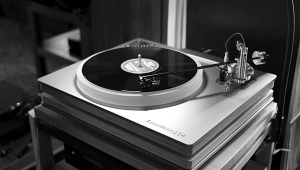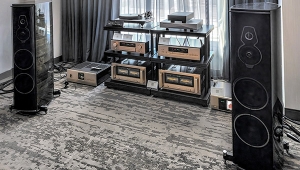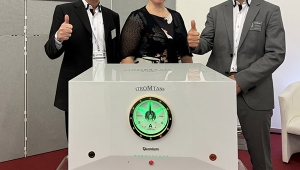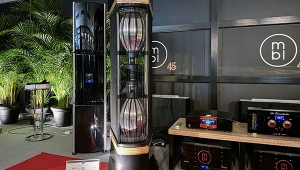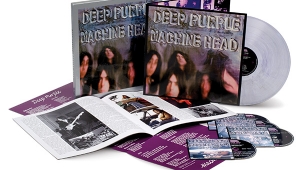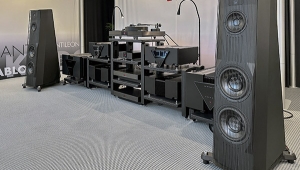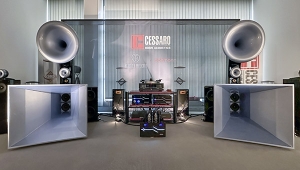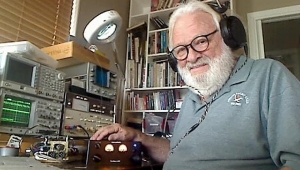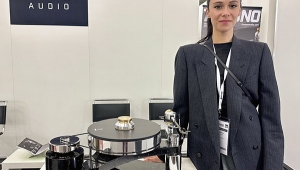| Columns Retired Columns & Blogs |
Krell KST-100 power amplifier Page 2
Martin Colloms returned to the KST-100 in October 1992 (Vol.15 No.10):
My plea to the industry to adopt a more conservative approach to product launches and upgrades leads into a "Follow-Up" on the sound of the current KST-100 power amplifier, a model on which I first reported in Stereophile Vol.14 No.7 (July 1991), together with the Krell KSL line controller. Since that review the $2950 KST has evolved; what has been at the dealers for the past nine months is in fact a significantly improved model.
One danger for this amplifier is its relationship to the rest of the Krell range, these massive components leaving the KST looking like a junior, rather less serious model. Please do the impossible and forget the rest of Krell's power-amplifier range for a moment. How does the KST-100 look now? This is no junior amp. On test, it produced 130Wpc into 8 ohms with negligible distortion. The very load-tolerant KST-100's 4 ohm delivery was 250W, and it finally began to hit the limits at 400Wpc into 2 ohms. Moreover, in pairs it may be used as a 400W 8 ohm monoblock, this option facilitated by the versatility offered by balanced and unbalanced audio inputs. The peak current delivery can reach ±40A, so this is no baby power amplifier.
Having set the stage for a serious view of its performance and potential standing in the marketplace, note the level of sound quality attained by the KST-100 at its introduction. Here it was rated as comparable to the discontinued KSA-80, itself once a leading example in its price category, and now replaced by the even better KSA-150B. The KST-100 was felt to have stepped into the place vacated by the KSA-80, succeeding at a substantially keener price.
On first review, the KST-100 acquitted itself very well, reaching the KSA-80's standard of sound quality without replicating the latter's particular character and balance of virtues. It was found to match the new KSL controller well, the combination representing good value. The KST-100 sounded more like the new larger, lower-feedback Krell amplifiers than the '80 itself, this difference associated with improved rhythm, a livelier, more dynamic midrange, and a more open quality. (A certain mild "darkening" had been perceptible on some Krell amplifiers of a few years ago.)
Where the KST conceded fractionally to its relatively moderate price was in the treble, which, though patently detailed and informative, had a tinge of "zzz" high in the range, a touch of "carelessness" reminiscent of tracking problems heard with some wide-band pickup cartridges. The upper treble simply did not sound as integrated or as smooth as the rest of the audible range. Nevertheless, with careful choice of loudspeaker and sources, a system balance could be found where even this may be induced to fade to a negligible level. Despite its relatively moderate power supply and output stage, the KST-100 can rock with some of the best of them, and offers powerful deep bass. By normal standards, it is still well endowed in the muscle department.
So how does the current '92/'93 KST-100 compare? Remembering that small improvements are hard-won at this elevated level, the KST shows an absolute improvement in subjective quality of nearly 10%. One could pay several thousand dollars more for such an increase.
While this improvement is characterized by an all-around gain in quality, the change is most noticeable in the amplifier's treble, which is now virtually in the KSA class, characterized by fine definition and control without excessive brightness. Judged by the very best standards the treble could still be regarded as a little dry, but in practical terms it remains very good.
The KST amplifier is capable of strongly defined, well-focused stereo images of very good width and fine depth. Even in such areas as transparency, the standard is high enough to allow a close comparison with references in the class of the Audio Research Classic 60. Fundamentally neutral, the current KST goes well with analog and the smoother digital sources, and also made a serious attempt to drive the Wilson WATT 3/Puppy 2 speakers to a decent standard.
A warmer, more natural tonal quality is also evident in the midrange, a better match to digital sources. The sound seems more relaxed, less forced, and yet dramatic expression is improved—a nice combination, this. And the solid, articulate bass standard is preserved.
So what separates the KST-100 and KSA-150B? Superficially they are remarkably close in merit, yet significant differences do emerge in direct comparison, differences which point to the KSA's greater authority and ultimate superiority. When the going gets tough, when heavy transients are present when the amplifier is asked to drive more difficult loads, the KSA has more "grunt," in context sounding unburstable. The KST's bass lines, a touch lighter, cannot generate quite the same degree of "slam." The KSA's sound also remains a little sweeter and more relaxed.
That adverse-load-driving "grunt" is what separates the Krells in general from more agile and elegant performers like the Meridian 605. Given the range of speakers and conditions which my listening-station amplifiers have to endure, there is a firm place for both the Krells and the Meridians. Where the Krell has absolute load-driving authority, it sounds a little calm and laid-back; it is the 605 which sets the pace in rhythmic terms if mated to a load which it favors.
Evolutionary developments in the Krell KST-100 have refined its performance to a level where it takes its place as a class leader. Don't misjudge this amplifier as the "baby" of Krell's power range. It is a serious 130W + 130W example in its own right, one of which many competitors would be rightly proud. Its value for money is unquestioned.—Martin Colloms
- Log in or register to post comments
















